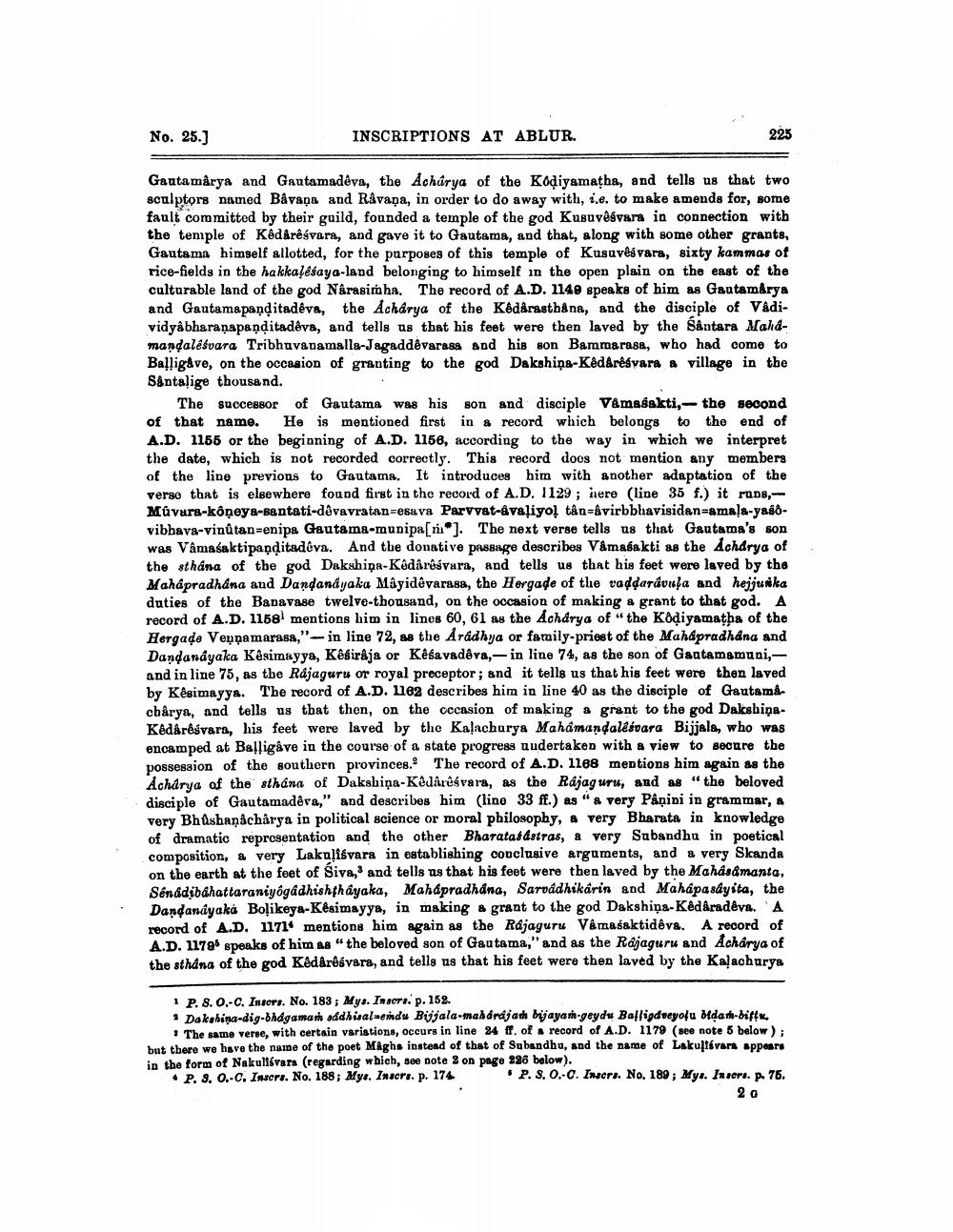________________
No. 25.)
INSCRIPTIONS AT ABLUR.
225
Gautamärya and Gautamadeva, the Acharya of the Kodiyamatha, and tells us that two sculptors named Båvana and Råvana, in order to do away with, i.e. to make amends for, some fault committed by their guild, founded a temple of the god Kusuvesvara in connection with the temple of Kêdårêsvara, and gave it to Gautama, and that, along with some other grants, Gautama himself allotted, for the purposes of this temple of Kusuvešvara, sixty kammas of rice-fields in the hakkaļéśaya-land belonging to himself in the open plain on the east of the cultarable land of the god Narasimha. The record of A.D. 1140 speaks of him as Gautam&rya and Gautamapanditadêva, the Acharya of the Kedårastbana, and the disciple of Vadividyabharaṇapanditadêva, and tells us that his feet were then laved by the Santara Mahdmandalesvara Tribhuvanamalla-Jagaddêvarasa and his son Bammarasa, who had come to Balligáve, on the occasion of granting to the god Dakshina-Ked&résvara & village in the Santalige thousand.
The successor of Gautama was his son and disciple Våmasakti,- the second of that name. He is mentioned first in a record which belongs to the end of A.D. 1155 or the beginning of A.D. 1156, according to the way in which we interpret the date, which is not recorded correctly. This record does not mention any members of the line previons to Gautama. It introduces him with another adaptation of the verse that is elsewhere found first in the record of A.D. 1129 ; iere (line 35 f.) it runs,Múvara-kôņeya-Bantati-devavratan=esava Parvvat-åvaļiyol tån=&virbbhavisidan-amala-yakovibhava-vinûtan=enipa Gautama-munipa[r]. The next verse tells us that Gautama's son was Vámasaktipa ditadêva. And the donative passage describes Vámasakti as the Acharya of the sthana of the god Dakshiņa-Kodarośvara, and tells us that his feet were laved by the Mahápradhana and Dandandyaka Máyidêvarasa, the Hergade of the vaddardoula and hejjunika duties of the Banavase twelve-thousand, on the occasion of making a grant to that god. A record of A.D. 11581 mentions him in lines 60, 61 as the Acharya of "the Kodiyamatha of the Hergade Veụnamarasa," - in line 72, as the Aradhya or family-priest of the Mahapradhana and Dandanayaka Kesimayya, Kéfir&ja or Kéśavadêva, - in line 74, as the son of Gaatamamani, and in line 75, as the Rajagutu or royal preceptor; and it tells us that his feet were then laved by Kesimayya. The record of A.D. 1162 describes him in line 40 as the disciple of Gautama. chårya, and tells us that then, on the occasion of making a grant to the god DaksbiņaKedårêśvara, his feet were laved by the Kalacharya Mahamandalêsvara Bijjala, who was encamped at Balligåve in the course of a state progress audertaken with a view to secure the possession of the southern provinces. The record of A.D. 1168 mentions him again as the Acharya of the sthana of Dakshiņa-Kedáreśvara, as the Rajag uru, and as "the beloved disciple of Gautamadêra," and describes him (line 33 ff.) as "a very Påņini in grammar, a very Bhushanacharya in political science or moral philosophy, a very Bharata in knowledge of dramatic representation and the other Bharatafdstras, a very Subandhu in poetical composition, a very Lakuļiśvara in establishing conclusive arguments, and a very Skanda on the earth at the feet of Siva,' and tells us that his feet were then laved by the Mahasamanta, Sénadibdhattaraniyôgádhishthayaka, Mahápradhdna, Sarvadhikarin and Mahapasayita, the Dandandyaká Boļikeya-Kesimayya, in making a grant to the god Dakshiņa-Kedåradêve. A record of A.D. 1171* mentions him again as the Rajaguru Vâmasaktidêva. A record of A.D. 11796 speaks of him as "the beloved son of Gautama," and as the Rajaguru and Acharya of the sthana of the god Kedåreśvara, and tells us that his feet were then laved by the Kalacharya
I P.8.0.-C. Insors. No. 183; Mys. Insero. p. 152.
Dakahina-dig-Bhdgamark addhisal-eindu Büjala-mahardjah bijayan-geydu Balli dveyofu Mida-diffu
1 The same verse, with certain variations, occurs in line 84 ff. of record of A.D. 1179 (see note 5 below): but there we have the name of the poet Magha instead of that of Subandhu, and the name of Lakultivars appears in the form of Nakulisvara (regarding which, 500 note on page 296 below). P. 3. 0.-c. Inseri. No. 188; Mye. Inacre. p. 174
P.S..-. Insera. No. 189; Myu. Inseri. p. 76.
20




